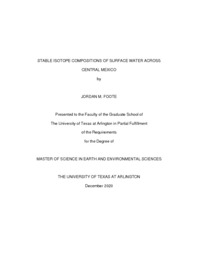
ATTENTION: The works hosted here are being migrated to a new repository that will consolidate resources, improve discoverability, and better show UTA's research impact on the global community. We will update authors as the migration progresses. Please see MavMatrix for more information.
Show simple item record
| dc.contributor.advisor | Fan, Majie | |
| dc.creator | Foote, Jordan | |
| dc.date.accessioned | 2022-01-21T19:26:26Z | |
| dc.date.available | 2022-01-21T19:26:26Z | |
| dc.date.created | 2020-12 | |
| dc.date.issued | 2020-12-09 | |
| dc.date.submitted | December 2020 | |
| dc.identifier.uri | http://hdl.handle.net/10106/30182 | |
| dc.description.abstract | Understanding the controlling factors of modern surface water stable isotope compositions is important for reconstructions of paleoclimate and paleoelevation. Few studies have attempted to understand patterns of surface water isotope compositions and their controlling factors in Mexico. Here I study the δ18O, δD and d-excess values of 124 modern river, lake and spring water samples across the Sierra Madre Occidental, Central Mexican Plateau and Sierra Madre Oriental to constrain the spatial pattern and lapse rate. These samples were collected at various elevations after the wet season in 2019. The isotope data were integrated with moisture back trajectory analysis and climatic and geographic data to understand the controlling factors of the pattern and rate. The moistures were predominantly from oceans along the coasts and continental recycled moisture accounts for ~17% of the total in arid Central Mexican Plateau. The isotope compositions decrease generally from coastal regions to the mountains, and the lake water isotope data display the largest variations, particularly in the arid highland in the continental interior, because of evaporation. The δ18O isotope lapse rates are small, -0.9‰/km for rivers and -1.4‰/km for springs in the Sierra Madre Occidental because of the catchment effect on both water types and evaporation of river water in the lowland. The local meteoric water lines of different water types are between 4.9 and 5.6, lower than that of the Global Meteoric Water Line, suggesting the influence of evaporation. A comparison of my surface water isotope data with previously published groundwater and precipitation isotope data suggests that the groundwater and our surface water all sourced from precipitation, and the groundwater experienced some degree of evaporation. The new understanding has implications for reconstructions of regional paleoelevation. | |
| dc.format.mimetype | application/pdf | |
| dc.language.iso | en_US | |
| dc.subject | Isotope | |
| dc.subject | Mexico | |
| dc.subject | Water | |
| dc.subject | Hydrology | |
| dc.subject | Geochemistry | |
| dc.subject | Oxygen | |
| dc.title | Stable isotope composition of surface water across central Mexico | |
| dc.type | Thesis | |
| dc.degree.department | Earth and Environmental Sciences | |
| dc.degree.name | Master of Science in Earth and Environmental Science | |
| dc.date.updated | 2022-01-21T19:26:26Z | |
| thesis.degree.department | Earth and Environmental Sciences | |
| thesis.degree.grantor | The University of Texas at Arlington | |
| thesis.degree.level | Masters | |
| thesis.degree.name | Master of Science in Earth and Environmental Science | |
| dc.type.material | text | |
Files in this item
- Name:
- FOOTE-THESIS-2020.pdf
- Size:
- 1.263Mb
- Format:
- PDF
This item appears in the following Collection(s)
Show simple item record


